Fragaria vesca
| Fragaria vesca | |
|---|---|
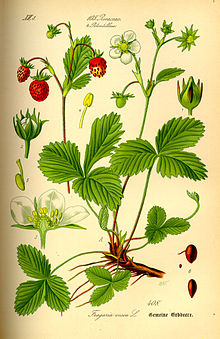
| |
| Scientific classification | |
| Kingdom: | Plantae |
| Clade: | Tracheophytes |
| Clade: | Angiosperms |
| Clade: | Eudicots |
| Clade: | Rosids |
| Order: | Rosales |
| Family: | Rosaceae |
| Genus: | Fragaria |
| Species: | F. vesca |
| Binomial name | |
| Fragaria vesca | |
Fragaria vesca, commonly called the wild strawberry, woodland strawberry, Alpine strawberry, Carpathian strawberry or European strawberry, is a perennial herbaceous plant in the rose family that grows naturally throughout much of the Northern Hemisphere, and that produces edible fruits.[2][3]
The Latin specific epithet vesca may mean "thin, feeble",[4] however it likely derives in the sense of "edible" from vescere "to eat, feed upon".[5]
Description
Five to eleven soft, hairy white flowers are borne on a green, soft fresh-hairy 3–15 centimetres (1–6 in) stalk that usually lifts them above the leaves. The light-green leaves are trifoliate (in threes) with toothed margins. The plant spreads mostly by means of runners (stolons), but the seeds are viable and establish new populations.[6][7][8]
Taxonomy
Vilmorin-Andrieux (1885) makes a distinction between wild or wood strawberries (Fragaria vesca) and alpine strawberries (Fragaria alpina),[9] a distinction which is not made by most seed companies or nurseries, which usually sell Fragaria vesca as "alpine strawberry".
Under wild or wood strawberry, Vilmorin says:
It has seldom been seen in gardens since the introduction of the Red Alpine Strawberry. ... Wood Strawberry possesses a quite particular perfume and delicacy of flavour. 2,500 seeds to the gramme.
Under alpine strawberry, Vilmorin says:
A very different plant to the Wood Strawberry, and distinguished by the greater size of all its parts — the fruit in particular — and especially by the property (which is particular to it) of producing flowers and fruit continuously all through the summer. ... The fruit has nearly the same appearance and flavour as that of the Wood Strawberry, but is generally larger, longer, and more pointed in shape. The seed is also perceptibly larger and longer. A gramme contains only about 1,500 seeds.
Subspecies
As of November 2020, Plants of the World Online accepts two subspecies in addition to the autonym, Fragaria vesca ssp. vesca:[1]
- Fragaria vesca ssp. americana (Porter) Staudt
- Fragaria vesca ssp. bracteata (A.Heller) Staudt
Ecology
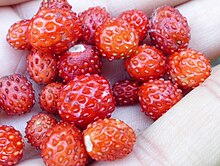
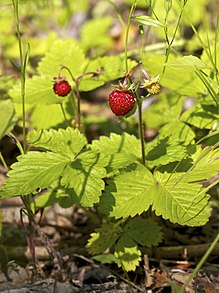

Typical habitat is along trails and roadsides, embankments, hillsides, stone- and gravel-laid paths and roads, meadows, young woodlands, sparse forest, woodland edges, and clearings. Often plants can be found where they do not get sufficient light to form fruit. In the southern part of its range, it can grow only in shady areas; further north it tolerates more sun.[10] It is tolerant of a variety of moisture levels (except very wet or dry conditions).[10] It can survive mild fires and/or establish itself after fires.[10]
Although F. vesca primarily propagates via runners, viable seeds are also found in soil seed banks and seem to germinate when the soil is disturbed (away from existing populations of F. vesca).[10]
Its leaves serve as significant food source for a variety of ungulates, such as mule deer and elk, and the fruit are eaten by a variety of mammals and birds that also help to distribute the seeds in their droppings.[10]
It is a larval host to the two-banded checkered skipper.[11]
Genomics
| NCBI genome ID | 3314 |
|---|---|
| Ploidy | diploid |
| Number of chromosomes | 14 |
| Year of completion | 2010 |
The wild strawberry is used as an indicator plant for diseases that affect the garden strawberry. It is also used as a genetic model plant for garden strawberry and the family Rosaceae in general, due to its:
- very small genome size
- short reproductive cycle (14–15 weeks in climate-controlled greenhouses)
- ease of propagation.
The genome of F. vesca was sequenced in 2010,[12] and with greater detail and accuracy in 2017 by the Knapp UC Davis program.[13]
All strawberry (Fragaria) species have a base haploid count of seven chromosomes; Fragaria vesca is diploid, having two pairs of these chromosomes for a total of 14.
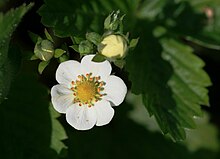


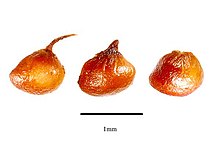
History, cultivation and uses
Evidence from archaeological excavations suggests that Fragaria vesca has been consumed by humans since the Stone Age.[14]
Woodland strawberry fruit is strongly flavored, and is still collected and grown for domestic use and on a small scale commercially for the use of gourmets and as an ingredient for commercial jam, sauces, liqueurs, cosmetics and alternative medicine. In Turkey, hundreds of tons of wild fruit are harvested annually, mainly for export.[15]
Most of the cultivated varieties have a long flowering period (and have been considered by botanists as belonging to Fragaria vesca var. vesca ssp. semperflorens). They are usually called alpine strawberries. They either form runners or multiple crowns in a cluster, fruit over a very long period with larger fruit than the common wood strawberry, and are usually propagated by seeds or division of the plants. The type in cultivation is usually everbearing and produces few runners. Plants tend to lose vigour after a few years due to their abundant fruiting and flowering with final decline caused by viral diseases.[16] Large-fruiting forms are known since the 18th century and were called "Fressant" in France.[17] Some cultivars have fruit that are white or yellow when fully ripe, instead of the normal red.
Cultivars that form stolons are often used as groundcover, while cultivars that do not may be used as border plants. Some cultivars are bred for their ornamental value. Hybrids, Fragaria × vescana, have been created from crosses between woodland strawberry and garden strawberry. Hybrids between the woodland strawberry and the European species Fragaria viridis were in cultivation until around 1850, but are now lost.[18]
Alpine strawberry has an undeserved reputation among home gardeners as hard to grow from seed, often with rumors of long and sporadic germination times, cold pre-chilling requirements, etc.[citation needed] In reality, with proper handling of the very small seeds (which can easily be washed away with rough watering), 80% germination rates at 70 °F (21 °C) in 1–2 weeks are easily achievable.[citation needed]
Alpine strawberries are sometimes included as edging plants in herbaceous borders.[19]
Garden varieties currently in cultivation
- Seed-propagated
- Rügen, the first modern cultivar, i.e., runnerless, everbearing and large fruited — originating from Castle Putbus in Germany, first offered 1920 by the strawberry grower Emil Spangenberg from Morsleben.
- Alexandria, first offered 1964 by George W. Park Seed Co., USA
- Baron Solemacher, first offered 1935 by F. C. Heinemann, Germany
- Weisse Solemacher (white fruited) first offered by F. C. Heinemann
- Golden Alexandria (golden foliage).
- Cultivars
Forms with runners are still found in old gardens.
- Quarantaine de Prin, France; commercially important before World War I, but now almost extinct; maybe identical to the variety Erigée de Poitou which was still offered around 1960.
- Blanc Amélioré, Great Britain; white-fruited; it is doubtful if the clone in circulation today is identical to the historical variety from around 1900 because of its non-everbearing habit; nevertheless a good variety with rather large, sometimes monstrous fruit of the Fressant type.
- Illa Martin, Germany; sold as an ornamental, white-fruited. Red achenes have been reported but have not been found. Most plants in circulation not true to name.
- Gartenfreude, Germany; large-fruited form, sometimes very large monstrous fruit of the Fressant type.
Curious mutations have arisen and are sometimes grown by plantsmen and other connoisseurs of the unusual:
- Monophylla (“Strawberry of Versailles”; has one large leaflet instead of the normal three leaflets)[23] - Vilmorin-Andrieux (1885) stated as being raised by Duchesne.[9]
- Multiplex (double flowered; sets less and smaller fruit)
- Muricata (“Plymouth strawberry”; the flowers are composed of numerous small, leafy bracts; the fruit are similarly spiky).
Chemistry
F. vesca contains the ellagitannin agrimoniin which is an isomer of sanguiin H-6.[24]
See also
References
- ^ a b "Fragaria vesca L." Plants of the World Online. Royal Botanic Gardens, Kew. Retrieved 2020-11-12.
- ^ Sullivan, Steven. K. (2015). "Fragaria vesca". Wildflower Search. Retrieved 2015-06-16.
- ^ NRCS. "Fragaria vesca". PLANTS Database. United States Department of Agriculture (USDA). Retrieved 2015-06-16.
- ^ Harrison, Lorraine (2012). RHS Latin for Gardeners. United Kingdom: Mitchell Beazley. ISBN 978-1845337315.
- ^ Genaust, Helmut (1976). Etymologisches Wörterbuch der botanischen Pflanzennamen. doi:10.1007/978-3-0348-7650-6. ISBN 978-3-0348-7651-3.
- ^ Klinkenberg, Brian, ed. (2014). "Fragaria vesca". E-Flora BC: Electronic Atlas of the Plants of British Columbia [eflora.bc.ca]. Lab for Advanced Spatial Analysis, Department of Geography, University of British Columbia, Vancouver. Archived from the original on 2017-08-28. Retrieved 2015-06-16.
- ^ Giblin, David, ed. (2015). "Fragaria vesca". WTU Herbarium Image Collection. Burke Museum, University of Washington. Retrieved 2015-06-16.
- ^ "Fragaria vesca". Jepson eFlora: Taxon page. Jepson Herbarium; University of California, Berkeley. 2015. Retrieved 2015-06-16.
- ^ a b Vilmorin-Andrieux et cie (1885). The Vegetable Garden. London: J. Murray. pp. 538–539.
- ^ a b c d e Munger, Gregory T. (2006). "Fragaria vesca". Fire Effects Information System (FEIS). US Department of Agriculture (USDA), Forest Service (USFS), Rocky Mountain Research Station, Fire Sciences Laboratory. Retrieved 2008-08-06.
- ^ The Xerces Society (2016), Gardening for Butterflies: How You Can Attract and Protect Beautiful, Beneficial Insects, Timber Press.
- ^ Shulaev, Vladimir; et al. (December 2010). "The genome of woodland strawberry (Fragaria vesca)". Nature. 43 (2): 109–116. doi:10.1038/ng.740. PMC 3326587. PMID 21186353.
- ^
- • Edger, Patrick P; VanBuren, Robert; Colle, Marivi; Poorten, Thomas J; Wai, Ching Man; Niederhuth, Chad E; Alger, Elizabeth I; Ou, Shujun; Acharya, Charlotte B; Wang, Jie; Callow, Pete; McKain, Michael R; Shi, Jinghua; Collier, Chad; Xiong, Zhiyong; Mower, Jeffrey P; Slovin, Janet P; Hytönen, Timo; Jiang, Ning; Childs, Kevin L; Knapp, Steven J (2017). "Single-molecule sequencing and optical mapping yields an improved genome of woodland strawberry (Fragaria vesca) with chromosome-scale contiguity". GigaScience. 7 (2). Oxford University Press (OUP) & Beijing Genomics Institute: 1–7. doi:10.1093/gigascience/gix124. ISSN 2047-217X. PMC 5801600. PMID 29253147. S2CID 3583016.
- • Liu, Zhongchi; Ma, Hong; Jung, Sook; Main, Dorrie; Guo, Lei (2020). "Developmental Mechanisms of Fleshy Fruit Diversity in Rosaceae". Annual Review of Plant Biology. 71 (1). Annual Reviews: 547–573. doi:10.1146/annurev-arplant-111119-021700. ISSN 1543-5008. PMID 32442388. S2CID 218856801.
- • Bushakra, J.M.; Alice, L.A.; Carter, K.A.; Dossett, M.; Lee, J.C.; Liston, A.; Meiers, R.; Mulch, C.; Nyberg, A.M.; Peterson, M.E.; Clark, M.; Vining, K.J.; Worthington, M.L.; Yin, M.H.; Sutherland, B.L.; Zurn, J.D.; Clark, J.R.; Finn, C.E.; Bassil, N.V.; Hummer, K.E. (2020). Status of Rubus germplasm at the US National Clonal Germplasm Repository in Corvallis, Oregon. XII International Rubus and Ribes Symposium: Innovative Rubus and Ribes Production for High Quality Berries in Changing Environments. Acta Horticulturae. No. 1277. International Society for Horticultural Science (ISHS). pp. 121–128. doi:10.17660/actahortic.2020.1277.17. ISSN 0567-7572.
- • Whitaker, Vance M.; Knapp, Steven J.; Hardigan, Michael A.; Edger, Patrick P.; Slovin, Janet P.; Bassil, Nahla V.; Hytönen, Timo; Mackenzie, Kathryn K.; Lee, Seonghee; Jung, Sook; Main, Dorrie; Barbey, Christopher R.; Verma, Sujeet (2020). "A roadmap for research in octoploid strawberry". Horticulture Research. 7 (1). Nature + Nanjing Agricultural University: 33. Bibcode:2020HorR....7...33W. doi:10.1038/s41438-020-0252-1. ISSN 2662-6810. PMC 7072068. PMID 32194969. S2CID 212706734.
- • Mayrose, Itay; Lysak, Martin A (2020). "The Evolution of Chromosome Numbers: Mechanistic Models and Experimental Approaches". Genome Biology and Evolution. 13 (2). Oxford University Press (Society for Molecular Biology & Evolution). doi:10.1093/gbe/evaa220. ISSN 1759-6653. PMC 7875004. PMID 33566095.
- • Liu, Zhao-Yu; Xing, Jian-Feng; Chen, Wei; Luan, Mei-Wei; Xie, Rui; Huang, Jing; Xie, Shang-Qian; Xiao, Chuan-Le (2019). "MDR: an integrative DNA N6-methyladenine and N4-methylcytosine modification database for Rosaceae". Horticulture Research. 6 (1). Nature + Nanjing Agricultural University: 78. Bibcode:2019HorR....6...78L. doi:10.1038/s41438-019-0160-4. ISSN 2052-7276. PMC 6572862. PMID 31240103. S2CID 189819178.
- • Jung, Sook; Lee, Taein; Cheng, Chun-Huai; Buble, Katheryn; Zheng, Ping; Yu, Jing; Humann, Jodi; Ficklin, Stephen P; Gasic, Ksenija; Scott, Kristin; Frank, Morgan; Ru, Sushan; Hough, Heidi; Evans, Kate; Peace, Cameron; Olmstead, Mercy; DeVetter, Lisa W; McFerson, James; Coe, Michael; Wegrzyn, Jill L; Staton, Margaret E; Abbott, Albert G; Main, Dorrie (2018). "15 years of GDR: New data and functionality in the Genome Database for Rosaceae". Nucleic Acids Research. 47 (D1). Oxford University Press (OUP): D1137 – D1145. doi:10.1093/nar/gky1000. ISSN 0305-1048. PMC 6324069. PMID 30357347. S2CID 53031442.
- • Li, Yongping; Pi, Mengting; Gao, Qi; Liu, Zhongchi; Kang, Chunying (2019). "Updated annotation of the wild strawberry Fragaria vesca V4 genome". Horticulture Research. 6 (1). Nature (Nanjing Agricultural University): 61. Bibcode:2019HorR....6...61L. doi:10.1038/s41438-019-0142-6. ISSN 2052-7276. PMC 6491553. PMID 31069085. S2CID 140335118.
- • Renner, Susanne S.; Müller, Niels A. (2021). "Plant sex chromosomes defy evolutionary models of expanding recombination suppression and genetic degeneration". Nature Plants. 7 (4). Nature Portfolio: 392–402. Bibcode:2021NatPl...7..392R. doi:10.1038/s41477-021-00884-3. ISSN 2055-0278. PMID 33782581. S2CID 232421827.
- • Gaston, Amelia; Osorio, Sonia; Denoyes, Béatrice; Rothan, Christophe (2020). "Applying the Solanaceae Strategies to Strawberry Crop Improvement". Trends in Plant Science. 25 (2). Cell Press: 130–140. Bibcode:2020TPS....25..130G. doi:10.1016/j.tplants.2019.10.003. ISSN 1360-1385. PMID 31699520. S2CID 207945187.
- • Liston, Aaron; Wei, Na; Tennessen, Jacob A.; Li, Junmin; Dong, Ming; Ashman, Tia-Lynn (2019). "Revisiting the origin of octoploid strawberry". Nature Genetics. 52 (1). Nature Portfolio: 2–4. doi:10.1038/s41588-019-0543-3. ISSN 1061-4036. PMID 31844319. S2CID 209381318.
- • Edger, Patrick P.; McKain, Michael R.; Yocca, Alan E.; Knapp, Steven J.; Qiao, Qin; Zhang, Ticao (2019). "Reply to: Revisiting the origin of octoploid strawberry". Nature Genetics. 52 (1). Nature Portfolio: 5–7. doi:10.1038/s41588-019-0544-2. ISSN 1061-4036. PMC 6960091. PMID 31844320. S2CID 209381682.
- ^ "Internet Archaeol 1. Tomlinson & Hall. 7". intarch.ac.uk. Retrieved 2017-08-28.
- ^ Ece Turhan and Sevgi Paydas Kargi (June 2007), "Strawberry Production in Turkey" (PDF), Chronica Horticulturae, 47 (2): 18–20, ISSN 0578-039X, archived from the original (PDF) on 2019-01-20, retrieved 2009-01-17
- ^ "Fragaria vesca 'Semperflorens'". Plants for a Future. Retrieved 2017-08-20.
- ^ Staudt, Günter (2003), Les dessins d'A. N. Duchesne pour son Histoire naturelle des fraisiers, Paris: Muséum Nat. d'histoire Naturelle
- ^ Staudt, Günter; Dimeglio, Laura M.; Davis, Thomas M.; Gerstberger, Pedro (December 2003), "Fragaria × bifera Duch.: Origin and taxonomy", Botanische Jahrbücher, 125 (1): 53–72, doi:10.1127/0006-8152/2003/0125-0053
- ^ "BBC - Gardening: Plant Finder - Alpine strawberry".
- ^ Wachsmuth, Brigitte (April 2009), "Von Monats-, Wald- und Moschuserdbeeren", Gartenpraxis, 35 (4): 20–28
- ^ Wachsmuth, Brigitte (December 2010), "Wild, alpine and musk strawberries", The Plantsman, 9 (part 4): 245–249
- ^ Wachsmuth, Brigitte (March 2014). "Annotated List of Alpine, Wild, and Musk Strawberry Varieties Currently in Cultivation". www.ipke.de. Retrieved 2017-08-20.
- ^ Chest of Books: William Curtis, The Botanical Magazine, or, Flower-Garden Displayed, Vol. 1
- ^ Vrhovsek, Urska; Guella, Graziano; Gasperotti, Mattia; Pojer, Elisa; Zancato, Mirella; Mattivi, Fulvio (2012), "Clarifying the Identity of the Main Ellagitannin in the Fruit of the Strawberry, Fragaria vesca and Fragaria ananassa Duch.", J. Agric. Food Chem., 60 (10): 2507–2516, doi:10.1021/jf2052256, PMID 22339338
External links
- "Fragaria vesca". Plants for a Future.
- Annotated List Alpine, Wild, and Musk Strawberry Varieties Currently in Cultivation
- www.funet.fi Lists some insects it is foodplant for

